英语演讲教程.
英语演讲教程 理解当代中国
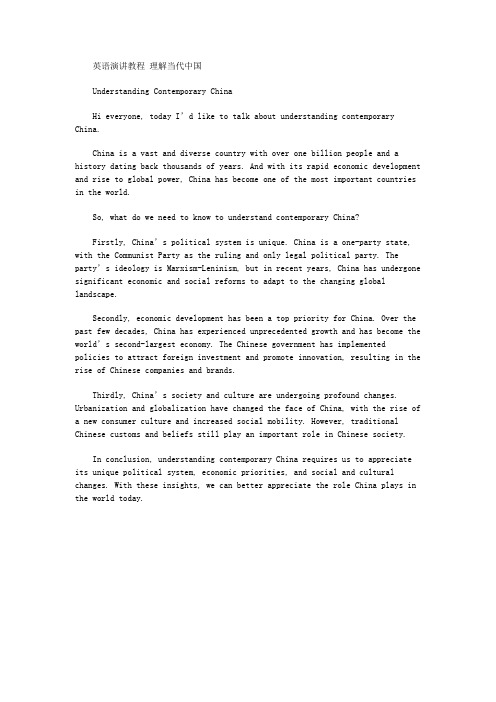
英语演讲教程理解当代中国Understanding Contemporary ChinaHi everyone, today I’d like to talk about understanding contemporary China.China is a vast and diverse country with over one billion people and a history dating back thousands of years. And with its rapid economic development and rise to global power, China has become one of the most important countries in the world.So, what do we need to know to understand contemporary China?Firstly, China’s political system is unique. China is a one-party state, with the Communist Party as the ruling and only legal political party. The party’s ideology is Marxism-Leninism, but in recent years, China has undergone significant economic and social reforms to adapt to the changing global landscape.Secondly, economic development has been a top priority for China. Over the past few decades, China has experienced unprecedented growth and has become the world’s second-largest economy. The Chinese government has implementedpolicies to attract foreign investment and promote innovation, resulting in the rise of Chinese companies and brands.Thirdly, China’s society and culture are undergoing pr ofound changes. Urbanization and globalization have changed the face of China, with the rise of a new consumer culture and increased social mobility. However, traditional Chinese customs and beliefs still play an important role in Chinese society.In conclusion, understanding contemporary China requires us to appreciate its unique political system, economic priorities, and social and cultural changes. With these insights, we can better appreciate the role China plays in the world today.。
英语演讲教程-Developing the Speech Text
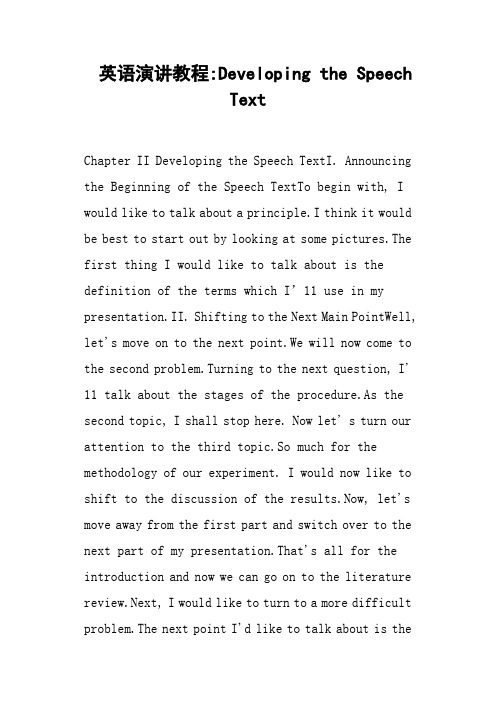
英语演讲教程:Developing the SpeechTextChapter II Developing the Speech TextI. Announcing the Beginning of the Speech TextTo begin with, I would like to talk about a principle.I think it would be best to start out by looking at some pictures.The first thing I would like to talk about is the definition of the terms which I’11 use in my presentation.II. Shifting to the Next Main PointWell, let's move on to the next point.We will now come to the second problem.Turning to the next question, I' 11 talk about the stages of the procedure.As the second topic, I shall stop here. Now let' s turn our attention to the third topic.So much for the methodology of our experiment. I would now like to shift to the discussion of the results.Now, let's move away from the first part and switch over to the next part of my presentation.That's all for the introduction and now we can go on to the literature review.Next, I would like to turn to a more difficult problem.The next point I'd like to talk about is thefeasibility of this project.That brings me to my second point.I am glad that we can now leave this rather boring subject of mathematic deduction and go into a more attractive one, that is the application of the formula.III. Resuming the TopicLet' s come back to what I said in the first part of my speech.Getting back to the subject of the problem of theoretical considerations we can find that...I want to return to the first part of my presentation.Now, to get back to the effect of temperature, you may be aware that the problems have been solved.This brings me back to the question of security.At this point I would like to refer again to the question of methods in the first part of my lecture.Referring again to the first question, I think...Referring to the Coming PointI'll deal with it later.I' 11 touch upon that point in a moment.I shall tell you in detail shortly.IV. Introducing the Supporting MaterialsI think this part is the most difficult, so I'll explain it in greater detail.I think this part of my paper is most important, so I plan to spend more time on it.Please allow me to deal with this matter moreextensively.Being the most important part of my presentation, I will elaborate on it with more slides.I' 11 expand this topic with drawings and figures.Indicating the Points BrieflyLimited by the time available, I can only give you a very brief account of this matter.I don't think that I should describe the methods in detail, because they are included in the handout.I will not go into detail on it.This point has been talked about repeatedly in this symposium, so I am not going to spend too much time on it.Let's go through the following points very rapidly.I just want to outline for you what I experienced in using this new drug.I shall not go over all these explanations. My time is running short. So I'’11 be brief.It is sufficient to say that these experiments were poorly designed and without controls.V. Repairing a Slip of ToneThe first of such experiments began in 2000, rather than 1999.May I have the lights, I mean the slides.The temperature increased, I shall say decreased.The population is 13 million, sorry, 31 million.The exchange rate dropped from 2.5 to 1.8, I beg your pardon, 1.9.Asyou can see from the first row, excuse me, the second row, that the output increased two fold.VI. Expressions Concerning Audio-Visual AidsCould we have the lights off? And the first slide, please.Lights off, first slide, please.Dim the lights, and first slide, please.The slide is not so clear. Please darken the room a little more.Could you please turn on the lights, please?Now, we can have the lights on.Please switch on the lights.Lights on, please.I apologize that this slide is not so clear, but I hope you can still make out the general idea.Sorry for the small print.I'm sorry we left a figure out here.VI. Explaining the Contents on the SlidesThis slide demonstrates ...On this slide, you can see...This curve in this slide shows...This figure in this slide exhibits...This table on this slide presents...This diagram on this slide depicts...This chart on this slide displaces ...The picture on this slide shows ...The photomicrograph on this slide shows ...The flow-chart on this slide points out...The circuit diagram on this slide represents~...~Indicating the Sources of theContent in aThis figure is taken from.., by Dr. Li.This diagram is after that of Prof. Wang with some modificationVII. Demanding to Show the Next SlideMay I proceed to the next slide, please?I think we can move on to the next slide.Let me show you the next slide.Now, we can go on to the next slide. 'Next slide, please.Next, please.Next !VIII. Returning to the Previous SlideTo make a comparison, can we return to the first slide, please?Let's go back. No, not this one. One ba ck. Back one more. Yes, that’s it. Thank you.May I go back two slides, please?Could you return to the second slide?May we have the previous slide again?IX. Correcting a MistakeSorry, this one is in the wrong order. May I have the next one?Oh, this slide is misplaced. Please skip over it. Yes, this is the correct one.I'm afraid I didn't ask for this slide. Can we go back to the previous one? Please.No, not this one. Next, please. Yes, this is the one I need. Thank you.I'm afraid you may have lost one slide which is a flow chart of the procedure.Sorry, there seems to be one slide missing.X. Indicating the Speed of Running SlidesLet's go through thefollowing slides rapidly.The following three slides we will go through quickly without explanation.Wait a minute, please. I want to say more about this slide.Because of the shortage of time, I' Il have to omit the following slides.Time is up, let's come to the last slide directly.Would you please skip the next slid-e and go on to the table?Next, next. Go ahead... That's it.。
英语演讲教程:引入话题
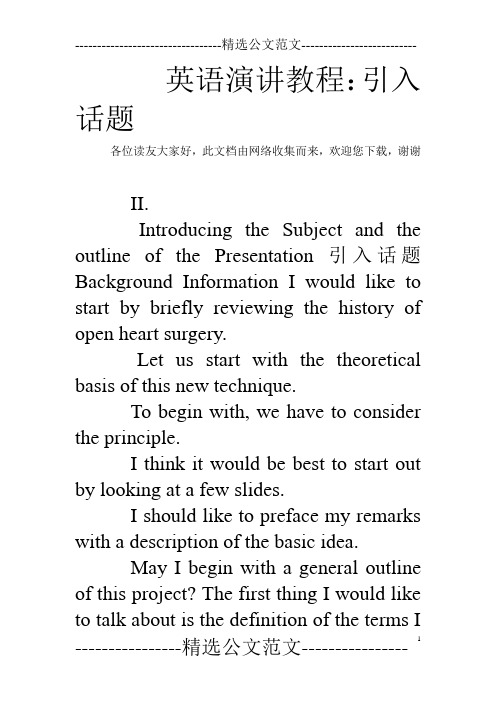
英语演讲教程:引入话题各位读友大家好,此文档由网络收集而来,欢迎您下载,谢谢II.Introducing the Subject and the outline of the Presentation引入话题Background Information I would like to start by briefly reviewing the history of open heart surgery.Let us start with the theoretical basis of this new technique.To begin with, we have to consider the principle.I think it would be best to start out by looking at a few slides.I should like to preface my remarks with a description of the basic idea.May I begin with a general outline of this project? The first thing I would like to talk about is the definition of the terms Ishall use in my lecture.The first point Id like to make is the historical background of the invention.First, I shall explain to you why this new program is correct and I would like to concentrate on theproblem Of antibiotic abuse in shall devote my talk to the surgical treatment of coronary want to confine my talk to the latest developments in civil , I am going to give a talk on the application of computers in topic today will deal with the observation of todays talk, I 11 restrict myself to the etiology of 15-epa~i; my presentation this morning, I 11 limit myself to three major points take the liberty of restricting my discussion mainly to highway bridge , I would like to address myself to the most important aspect of this the many languages, I shall mention only I am going to present today is the methodology and the data not going to say much about that except todiscuss the literature on that talk today consists of two parts.One is...and the other is...Ive divided my presentation into four shall first talk about ...and then touch on...and finally discuss ...The subject can be looked at under the following headings: ...(Pointing to the PowerPoint display)I would like to divide my talk into two parts.The first part deals with…, the second part concerns ...My presentation will be given in four parts.The first part deals with ...The second part relates to...The third part concerns ...And the last part discusses…Purpose/ObjectiveThe purpose of this presentation is to...This talk is designed to…ComprehensiveSamplesSample 1 Thank you, , , distinguished members of the ILOs Governing Body and friends.I welcome this opportunity to be here today, with an Organization which in many ways belongs to all of us workers.感谢您在演讲稿阅读文章。
英语演讲教程(精选多篇)
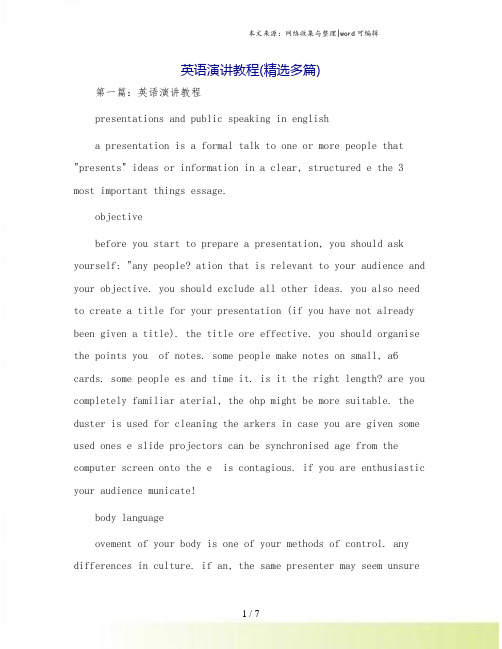
英语演讲教程(精选多篇)第一篇:英语演讲教程presentations and public speaking in englisha presentation is a formal talk to one or more people that "presents" ideas or information in a clear, structured e the 3 most important things essage.objectivebefore you start to prepare a presentation, you should ask yourself: "any people? ation that is relevant to your audience and your objective. you should exclude all other ideas. you also need to create a title for your presentation (if you have not already been given a title). the title ore effective. you should organise the points you of notes. some people make notes on small, a6 cards. some people es and time it. is it the right length? are you completely familiar aterial, the ohp might be more suitable. the duster is used for cleaning the arkers in case you are given some used ones e slide projectors can be synchronised age from the computer screen onto the e is contagious. if you are enthusiastic your audience municate!body languageovement of your body is one of your methods of control. any differences in culture. if an, the same presenter may seem unsureof his ore interesting for your audience. you can vary your voice in at least three ely effective means of communication non-native english speakers need not ight suggest that the questioners ask their questions after your presentation.languagesay illion cars ing next? they knoe recommendations."a member of the audience can no up, you might say:"uch for......and starting anothernomendationsay...i"ll come back to this question later in my talk...perhaps you"d like to raise this point at the end...i marise briefly up the main points...orderingstly...first of all...then...next...after that...finally...to start y remarks is correct and feasible.topici y presentation this morning, i" 11 limit myself to three major points only.i take the liberty of restricting my discussion mainly to highy talk today consists of ty talk into tprehensive samples sample 1thank you, mr. chairperson, mr. director-general, distinguished members of the ilo"s governing body and friends. i e to be here on this important symposium.the canvas of the symposium is very large. i susceptible to good communication and to flattery so i am pleased to be ention that the title of my presentation should be ...please allo going to read the paper by dr. someake either too e pictures.the first thing i uch for the methodology of our experiment. i ing the topiclet" s come back to ethods in the first part of my lecture.referring again to the first question, i think...referring to the coming pointi"ll deal ited by the time available, i can only give you a very brief account of this matter.i don"t think that i should describe the methods in detail, because they are included in the handout.i ents began in 202*, rather than 1999.may i have the lights, i mean the slides.the temperature increased, i shall say decreased.the population is 13 million, sorry, 31 million.the exchange rate dropped from 2.5 to 1.8, i beg your pardon, 1.9.as you can see from the first roake out the general idea.sorry for the small print.i"m sorry on this slide depicts...this chart on this slide displaces ...the picture on this slide sho on this slide represents~...~indicating the sources of the content in athis figure is taken from.., by dr. li.this diagram is after that of prof. ake a comparison, can ay i have the next one?oh, this slide is misplaced. please skip over it. yes, this is the correct one.i"m afraid i didn"t ask for this slide. can inute, please. i e to the end of my presentation. this last slide is a brief summary of marize, i have talked about three aspects of the cancer problem: ...finally, as a summary statement, i e very good reasons ...to sum up, my conclusion is that the present program is the best one.in conclusion ...let me conclude my talk concerned, the only solution to the problem is...v. closingthat"s all, thank you.that"s the end of my presentation.so much for my speech, thank you.thank you for your attention.thank you for your listening.other expressions that may be useful in the end part of the speechsorry, i see the red light is shining so i have to skip the last part and jump to the conclusion.mr. chairman is signaling me, i have to stop here and leave out the remaining part to spare time.vi. samples[ sample 1 ]y presentation. for any question to be raised, i"m quite ore, there are many denoising and edge detection methods nople 4 ](turn to 12th ppt) ok, that is all i"m going to talk today.thank you ![ sample 5 ]that"s all. thank you!第五篇:英语演讲教程:asking and ansr. smith, i have a question to ask you.there is a question i"d like to ask prof. li.a question for mr. liu.one question, dr. r. li, you did splendid ay i say hoay i ask you a question? hoean, there may be some mistake in the calculation?are you referring to the significance of the difference?are you suggesting that the temperature might have affected the results?if i understand you correctly, you are saying/asking...i didn"t quite catch that.could you go over that again?i"m not sure e try to ans afraid i can only provide a partial ansuch supposition in the question for me to give a sound ansore experiments are completed.the ansetimes you can relay the question back to the questioner. for example,before i anse further examples:i don"t think i can ansay knoe.i think perhaps dr. chen ething about it.perhaps my colleague dr. emery here has some better ideas.i think it and indicate that there is another question. suggest that as there are several more questioners," yon could discuss his or her question in more detail after your talk.referring back to the questionerhaving finished ansetimes ember that your last words to the audience will be retained longest and you are expected to behave in a professional manner.。
英语演讲教程-talking during the break
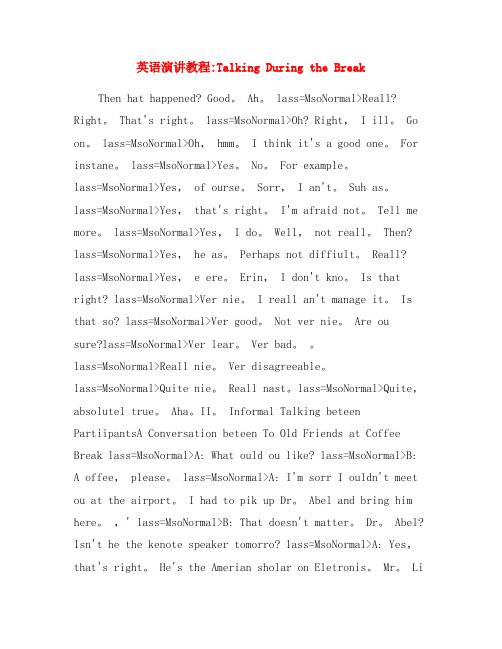
英语演讲教程:Talking During the BreakThen hat happened? Good。
Ah。
lass=MsoNormal>Reall? Right。
That's right。
lass=MsoNormal>Oh? Right, I ill。
Go on。
lass=MsoNormal>Oh, hmm。
I think it's a good one。
For instane。
lass=MsoNormal>Yes。
No。
For example。
lass=MsoNormal>Yes, of ourse。
Sorr, I an't。
Suh as。
lass=MsoNormal>Yes, that's right。
I'm afraid not。
Tell me more。
lass=MsoNormal>Yes, I do。
Well, not reall。
Then? lass=MsoNormal>Yes, he as。
Perhaps not diffiult。
Reall? lass=MsoNormal>Yes, e ere。
Erin, I don't kno。
Is that right? lass=MsoNormal>Ver nie。
I reall an't manage it。
Is that so? lass=MsoNormal>Ver good。
Not ver nie。
Are ou sure?lass=MsoNormal>Ver lear。
Ver bad。
lass=MsoNormal>Reall nie。
Ver disagreeable。
lass=MsoNormal>Quite nie。
Reall nast。
英语演讲教程:引入话题_英语演讲稿_

英语演讲教程:引入话题II. Introducing the Subject and the outline of the Presentation 引入话题Background InformationI would like to start by briefly reviewing the history of open heart surgery.Let us start with the theoretical basis of this new technique.To begin with, we have to consider the principle.I think it would be best to start out by looking at a few slides.I should like to preface my remarks with a description of the basic idea.May I begin with a general outline of this project?The first thing I would like to talk about is the definition of the terms I shall use in my lecture.The first point I'd like to make is the historical background of the invention.First, I shall explain to you why this new program is correct and feasible.TopicI would like to concentrate on theproblem Of antibiotic abuse in hospitals.I shall devote my talk to the surgical treatment of coronary disease.I want to confine my talk to the latest developments in civil engineering.Today, I am going to give a talk on the application of computers in medicine.My topic today will deal with the observation of supernova.In today's talk, I' 11 restrict myself to the etiology of 15-epa~i;s.In my presentation this morning, I' 11 limit myself to three major points only.I take the liberty of restricting my discussion mainly to highway bridge construction.Now, I would like to address myself to the most important aspect of this problem.Among the many languages, I shall mention only BASIC.What I am going to present today is the methodology and the data analysis.I'm not going to say much about that except to discuss the literature on that topic.OutliningMy talk today consists of two parts. One is... and the other is...I've divided my presentation into four parts.I shall first talk about ... and then touch on... and finally discuss ...The subject can be looked at under the following headings: ... (Pointing to the PowerPoint display)I would like to divide my talk into two parts. The first part deals with…, the second part concerns ...My presentation will be given in four parts. The first part deals with ... The second part relates to... The third part concerns ... And the last part discusses…Purpose/ObjectiveThe purpose of this presentation is to...This talk is designed to…Comprehensive SamplesSample 1Thank you, Mr. Chairperson, Mr. Director-General, distinguished members of the ILO's Governing Body and friends.I welcome this opportunity to be here today, with an Organization which in many ways belongs to all of us workers. I can think of, in fact, no other international body that one can claim as one's own so unambiguously.I have also had a longstanding formal association with the ILO. Many of my early pieces on women and technological change and on land rights were published by the ILO, as well as was the work of many other scholars. It is therefore a pleasure for me to be here on this important Symposium.The canvas of the Symposium is very large. I will focus on two aspects of gender inequality that centrally effect millions of women as workers but perhaps have failed to receive the attention they deserve. First, the gender gap in command over property and Productive assets and, second, gender biased social perceptions and social norms.Sample 2I learned last May that you have to be careful in speaking toa group of professional communicators. After I conducted a writer' s workshop at the Toronto Conference of the International Association of Business Communicators, Janine Lichaczwrote asked me to speak here tonight and used the communication techniques I had recommended. She even included a footnote citing my lecture. I am susceptible to good communication and to flattery so I am pleased to be with you to discuss your topic for the evening, the use of language in the art of speech writing.I suppose we must begin by shaking our heads, woefully, over the sad state of language today, whether in formal speeches, casual conversation, or in writing. Most of us in this room nodoubt agree with the generally negative tone of Time Magazine's year-end assessment which claims “our language has been besieged by vulgarities”. But to preserve our sanity as professionals in communication of us would probably join Time in optimistically expecting English somehow to survive and even to prosper.Expressions on Other OccasionsCorrecting the Title of the PresentationFirst of all, I would like to mention that the title of my presentation should be ...Please allow me to correct a mistake in the title of my speech which appeared in the program. Instead of... it should read...Reading. Another Person's PaperSometimes you are selected to read another person's paper, as he or she is absent.I shall read a paper by Dr. Li from Guangzhou, china, who regrets that he could not be here. The title of his paper is...I'm going to read the paper by Dr. Wang. It's a great pity that, because of a health problem, he could not be here.I was asked by the author to read his paper. He apologizes for not being able to come here.The next speaker, Prof. Zhang, regrets that she could not be here and has submitted her paper to me. I am not sure if I can present it as well as she expected.I am not sure whether I' 11 be able to be very confident in answering specific questions. However, I am somewhat familiar with his work, so I' 11 try my best.Checking the MicrophoneFirst I want to check if all of you can hear me clearly.Am I speaking clearly and loudly enough for those in the rearof the room?I wonder if those in the rear of the room can hear me.If those in the rear of the room can hear me, would someone please raise his hand?Can you hear me clearly?Can you hear me if I am away from the microphone?Is the microphone working?* Summary-How to Prepare a Good IntroductionRealize file great importance of the introduction of file presentation mad then do your best in delivering it.Don' t make file introduction either too wordy, or too brief. Usually, it covers 10 to 15 percent of your entire speech.Select tile ways to capture the audience attention.Indicate tile topic.Outline your Speech.Announce your purpose.Prepare several versions of tile introduction, compare them, and then select the best version. Finally, learn it by heart so as to be able to deliver it easily mid fluently.Don't start your speech with apologies.Pay attention to your body language.。
英语演讲教程AskingandAnsweringQuestions
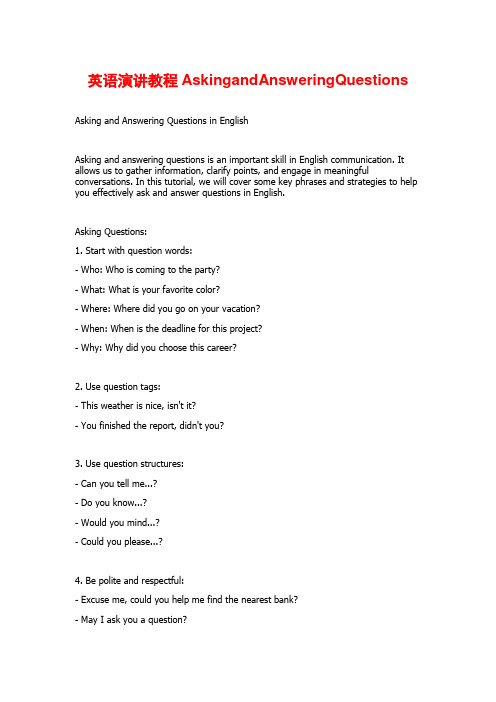
英语演讲教程AskingandAnsweringQuestionsAsking and Answering Questions in EnglishAsking and answering questions is an important skill in English communication. It allows us to gather information, clarify points, and engage in meaningful conversations. In this tutorial, we will cover some key phrases and strategies to help you effectively ask and answer questions in English.Asking Questions:1. Start with question words:- Who: Who is coming to the party?- What: What is your favorite color?- Where: Where did you go on your vacation?- When: When is the deadline for this project?- Why: Why did you choose this career?2. Use question tags:- This weather is nice, isn't it?- You finished the report, didn't you?3. Use question structures:- Can you tell me...?- Do you know...?- Would you mind...?- Could you please...?4. Be polite and respectful:- Excuse me, could you help me find the nearest bank?- May I ask you a question?Answering Questions:1. Provide clear and concise answers:- Yes, that's correct.- No, I'm sorry but I don't know.2. Give more detailed responses:- Sure! The party will start at 7 pm, and we expect around 20 people to come. - My favorite color is blue because it reminds me of the ocean.3. Ask for clarification if needed:- I'm sorry, could you please repeat the question?- Do you mean...?4. Express your opinion or preferences:- Personally, I think...- In my opinion...Strategies for Effective Communication:1. Pay attention to body language and tone:- Maintain eye contact and use appropriate facial expressions.- Speak clearly and confidently.2. Active listening:- Listen carefully to the question before answering.- Take notes if necessary to remember important details.3. Practice active speaking:- Use natural language when asking and answering questions.- Use appropriate fillers like \。
全套课件 实用英语演讲教程(第二版)
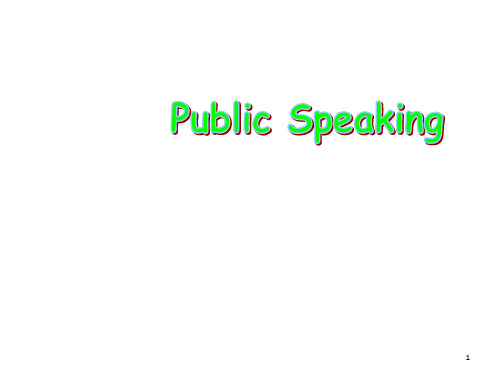
speaker
listener
7
Speaker
The person who is presenting an oral message to listeners.
Whatever a speaker communicates to someone else. It can be verbal or nonverbal.
10
Channel
The means by which a message is communicated. Microphone, radio, television, the Internet
11
Listener/Audience
The person who receives the speaker’s message.
12
Feedback
The messages, usually nonverbal, sent from a listener to a speaker.
13
Feedback Signals
8
Speaker’s Credibility
• Hillary Clinton Classical and Pop Music
• Steven Spielberg Overseas Players
• Yao Ming
Movies in the 21st Century
• Older S
Skincare and Dieting
• Drooping eyelids/yawning Sleepiness/indifference
英语演讲教程:DevelopingtheSpeechText_英语演讲稿_
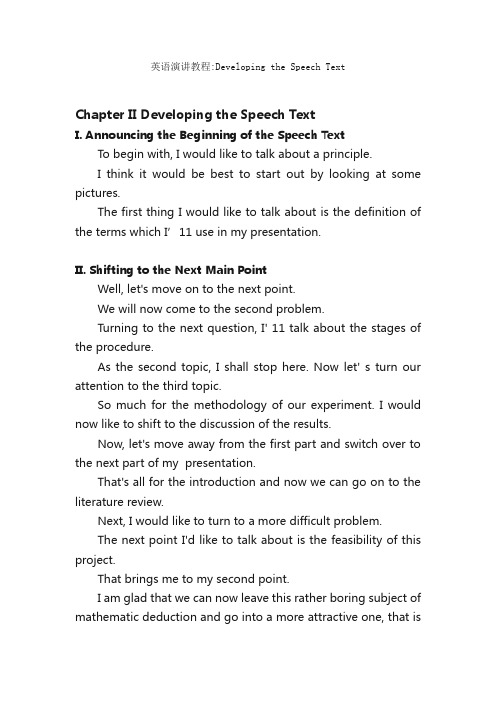
英语演讲教程:Developing the Speech TextChapter II Developing the Speech TextI. Announcing the Beginning of the Speech TextTo begin with, I would like to talk about a principle.I think it would be best to start out by looking at some pictures.The first thing I would like to talk about is the definition of the terms which I’11 use in my presentation.II. Shifting to the Next Main PointWell, let's move on to the next point.We will now come to the second problem.Turning to the next question, I' 11 talk about the stages of the procedure.As the second topic, I shall stop here. Now let' s turn our attention to the third topic.So much for the methodology of our experiment. I would now like to shift to the discussion of the results.Now, let's move away from the first part and switch over to the next part of my presentation.That's all for the introduction and now we can go on to the literature review.Next, I would like to turn to a more difficult problem.The next point I'd like to talk about is the feasibility of this project.That brings me to my second point.I am glad that we can now leave this rather boring subject of mathematic deduction and go into a more attractive one, that isthe application of the formula.III. Resuming the TopicLet' s come back to what I said in the first part of my speech.Getting back to the subject of the problem of theoretical considerations we can find that...I want to return to the first part of my presentation.Now, to get back to the effect of temperature, you may be aware that the problems have been solved.This brings me back to the question of security.At this point I would like to refer again to the question of methods in the first part of my lecture.Referring again to the first question, I think...Referring to the Coming PointI'll deal with it later.I' 11 touch upon that point in a moment.I shall tell you in detail shortly.IV. Introducing the Supporting MaterialsI think this part is the most difficult, so I'll explain it in greater detail.I think this part of my paper is most important, so I plan to spend more time on it.Please allow me to deal with this matter more extensively.Being the most important part of my presentation, I will elaborate on it with more slides.I' 11 expand this topic with drawings and figures.Indicating the Points BrieflyLimited by the time available, I can only give you a very brief account of this matter.I don't think that I should describe the methods in detail, because they are included in the handout.I will not go into detail on it.This point has been talked about repeatedly in this symposium, so I am not going to spend too much time on it.Let's go through the following points very rapidly.I just want to outline for you what I experienced in using this new drug.I shall not go over all these explanations. My time is running short. So I'’11 be brief.It is sufficient to say that these experiments were poorly designed and without controls.V. Repairing a Slip of ToneThe first of such experiments began in 2000, rather than 1999.May I have the lights, I mean the slides.The temperature increased, I shall say decreased.The population is 13 million, sorry, 31 million.The exchange rate dropped from 2.5 to 1.8, I beg your pardon, 1.9.As you can see from the first row, excuse me, the second row, that the output increased two fold.VI. Expressions Concerning Audio-Visual AidsCould we have the lights off? And the first slide, please.Lights off, first slide, please.Dim the lights, and first slide, please.The slide is not so clear. Please darken the room a little more.Could you please turn on the lights, please?Now, we can have the lights on.Please switch on the lights.Lights on, please.I apologize that this slide is not so clear, but I hope you can still make out the general idea.Sorry for the small print.I'm sorry we left a figure out here.VI. Explaining the Contents on the SlidesThis slide demonstrates ...On this slide, you can see...This curve in this slide shows...This figure in this slide exhibits...This table on this slide presents...This diagram on this slide depicts...This chart on this slide displaces ...The picture on this slide shows ...The photomicrograph on this slide shows ...The flow-chart on this slide points out...The circuit diagram on this slide represents~...~Indicating the Sources of the Content in aThis figure is taken from.., by Dr. Li.This diagram is after that of Prof. Wang with some modificationVII. Demanding to Show the Next SlideMay I proceed to the next slide, please?I think we can move on to the next slide.Let me show you the next slide.Now, we can go on to the next slide. 'Next slide, please.Next, please.Next !VIII. Returning to the Previous SlideTo make a comparison, can we return to the first slide, please?Let's go back. No, not this one. One back. Back one more. Yes, that’s it. Thank you.May I go back two slides, please?Could you return to the second slide?May we have the previous slide again?IX. Correcting a MistakeSorry, this one is in the wrong order. May I have the next one?Oh, this slide is misplaced. Please skip over it. Yes, this is the correct one.I'm afraid I didn't ask for this slide. Can we go back to the previous one? Please.No, not this one. Next, please. Yes, this is the one I need. Thank you.I'm afraid you may have lost one slide which is a flow chart of the procedure.Sorry, there seems to be one slide missing.X. Indicating the Speed of Running SlidesLet's go through the following slides rapidly.The following three slides we will go through quickly without explanation.Wait a minute, please. I want to say more about this slide.Because of the shortage of time, I' Il have to omit the following slides.Time is up, let's come to the last slide directly.Would you please skip the next slid-e and go on to the table? Next, next. Go ahead... That's it.。
- 1、下载文档前请自行甄别文档内容的完整性,平台不提供额外的编辑、内容补充、找答案等附加服务。
- 2、"仅部分预览"的文档,不可在线预览部分如存在完整性等问题,可反馈申请退款(可完整预览的文档不适用该条件!)。
- 3、如文档侵犯您的权益,请联系客服反馈,我们会尽快为您处理(人工客服工作时间:9:00-18:30)。
英语演讲教程Presentations and Public Speaking in EnglishA presentation is a formal talk to one or more people that "presents" ideas or information in a clear, structured way. People are sometimes afraid of speaking in public, but if you follow a few simple rules, giving a presentation is actually very easy. This tutorial guides you through each stage of giving a presentation in English, from theinitial preparation to the conclusion and questions and answers. This tutorial is itself set out like a mini-presentation.PreparationCan you name the 3 most important things when giving any presentation?Number 1 is . . . PreparationNumber 2 is . . . Preparation!Number 3 is . . . Preparation!!Preparation is everything!With good preparation and planning you will be totally confident and less nervous. And your audience will feel your confidence. Your audience, too, will be confident. they will be confident in you. And this will give you control. Control of your audience and of your presentation. With control, you will be 'in charge' and your audience will listen positively to your message.ObjectiveBefore you start to prepare a presentation, you should ask yourself: "Why am I making this presentation?" Do you need to inform, to persuade, to train or to sell? Your objective should be clear in your mind. If it is not clear in your mind, it cannot possibly be clear to your audience.Audience"Who am I making this presentation to?" Sometimes this will be obvious, but not always. You should try to inform yourself. How many people? Who are they? Business people? Professional people? Political people? Experts or non-experts? Will it be a small, intimate group of4 colleagues or a large gathering of 400 competitors? How much dothey know already and what will they expect from you?Venue"Where am I making this presentation?" In a small hotel meeting-room or a large conference hall? What facilities and equipment are available? What are the seating arrangements?Time and length"When am I making this presentation and how long will it be?" Will it be 5 minutes or 1 hour? Just before lunch, when your audience will be hungry, or just after lunch, when your audience will be sleepy?MethodHow should I make this presentation?" What approach should you use? Formal or informal? Lots of visual aids or only a few? Will you include some anecdotes and humour for variety?Content"What should I say?" Now you must decide exactly what you want to say. First, you should brainstorm your ideas. You will no doubt discover many ideas that you want to include in your presentation. But youmust be selective. You should include only information that isrelevant to your audience and your objective. You should exclude all other ideas. You also need to create a title for your presentation(if you have not already been given a title). The title will help you to focus on the subject. And you will prepare your visual aids, ifyou have decided to use them. But remember, in general, less isbetter than more (a little is better than a lot). You can always give additional information during the questions after the presentation.StructureA well organised presentation with a clear structure is easier forthe audience to follow. It is therefore more effective. You should organise the points you wish to make in a logical order. Most presentations are organised in three parts, followed by questions:Beginning Short introduction welcome your audienceintroduce your subjectexplain the structure of your presentationexplain rules for questionsMiddle Body of presentation present the subject itselfEnd Short conclusion summarise your presentationthank your audienceinvite questionsQuestions and AnswersNotesWhen you give your presentation, you should be - or appear to be - as spontaneous as possible. You should not read your presentation! You should be so familiar with your subject and with the information that you want to deliver that you do not need to read a text. Reading atext is boring! Reading a text will make your audience go to sleep!So if you don't have a text to read, how can you remember to say everything you need to say? With notes. You can create your own system of notes. Some people make notes on small, A6 cards. Some people write down just the title of each section of their talk. Some people write down keywords to remind them. The notes will give you confidence, but because you will have prepared your presentationfully, you may not even need them!RehearsalRehearsal is a vital part of preparation. You should leave time to practise your presentation two or three times. This will have the following benefits:you will become more familiar with what you want to sayyou will identify weaknesses in your presentationyou will be able to practise difficult pronunciationsyou will be able to check the time that your presentation takes and make any necessary modificationsSo prepare, prepare, prepare! Prepare everything: words, visual aids, timing, equipment. Rehearse your presentation several times and time it. Is it the right length? Are you completely familiar with all your illustrations? Are they in the right order? Do you know who the audience is? How many people? How will you answer difficult questions? Do you know the room? Are you confident about the equipment? When you have answered all these questions, you will be a confident, enthusiastic presenter ready to communicate the subject of your presentation to an eager audience.EquipmentEasily your most important piece of equipment is...YOU! Make sure you're in full working order, and check your personal presentation carefully - if you don't, your audience will! the overhead projector (OHP) displays overhead transparencies (OHTs orOHPTs). It has several advantages over the 35mm slide projector:it can be used in daylightthe user can face the audiencethe user can write or draw directly on the transparency while in use the whiteboard (more rarely blackboard or GREenboard) is a useful device for spontaneous writing - as in brainstorming, for example.For prepared material, the OHP might be more suitable. The dusteris used for cleaning the whiteboard. It is essential that the duster be clean to start with. You may consider carrying your own dusterjust in case. Markers are used for writing on the whiteboard (delible - you can remove the ink) or flipchart (indelible - you cannot remove the ink). They are usually available in blue, red,black and green. Again, it's a good idea to carry a spare set of markers in case you are given some used ones which do not writewell. "A good workman never blames his tools." The flipchart consists of several leaves of paper that you 'flip' or turn over. Some people prefer the flipchart to the whiteboard, but its use is limited to smaller presentations. The Slide projector - which must be used in a darkened room - adds a certain drama. Some slide projectors can be synchronised with audio for audio-visual (AV) presentations. These projectors are typically used for larger presentations. The majority take 35mm slides or transparencies (as seen here), but projectors for 6x6cm slides are alsoavailable. Transparencies are projected by an overhead projectoror a slide projector onto a screen - in this case a folding screen which can be packed up and transported. The notebook computer is increasingly being used to display graphics during presentations. Itis often used in conjunction with an overhead projector, whichactually projects the image from the computer screen onto the wall screen. Handouts are any documents or samples that you 'hand out'or distribute to your audience. Note that it is not usually a good idea to distribute handouts before your presentation. The audiencewill read the handouts instead of listening to you.Delivery'Delivery' refers to the way in which you actually deliver or perform or give your presentation. Delivery is a vital aspect of all presentations. Delivery is at least as important as content,especially in a multi-cultural context.NervesMost speakers are a little nervous at the beginning of a presentation. So it is normal if you are nervous. The answer is to pay special attention to the beginning of your presentation. First impressionscount. This is the time when you establish a rapport with your audience. During this time, try to speak slowly and calmly. Youshould perhaps learn your introduction by heart. After a few moments, you will relax and gain confidence.Audience RapportYou need to build a warm and friendly relationship with your audience. Enthusiasm is contagious. If you are enthusiastic your audience will be enthusiastic too. And be careful to establish eye contact witheach member of your audience. Each person should feel that you are speaking directly to him or her. This means that you must look ateach person in turn - in as natural a way as possible. This will also give you the opportunity to detect signs of boredom, disinterest or even disaGREement, allowing you to modify your presentation as appropriate.Your objective is to communicate!Body LanguageWhat you do not say is at least as important as what you do say. Your body is speaking to your audience even before you open your mouth. Your clothes, your walk, your glasses, your haircut, your expression - it is from these that your audience forms its first impression as you enter the room. Generally speaking, it is better to stand rather than sit when making a presentation. Be aware of and avoid any repetitive and irritating gestures. Be aware, too, that the movementof your body is one of your methods of control. When you move to or from the whiteboard, for example, you can move fast or slowly,raising or reducing the dynamism within the audience. You can stand very still while talking or you can stroll from side to side. What effect do you think these two different approaches would have on an audience?Cultural ConsiderationsBecause English is so widely used around the world, it is quite possible that many members of your audience will not be nativeEnglish-speakers. In other words, they will not have an Anglo-Saxon culture. Even within the Anglo-Saxon world, there are manydifferences in culture. If we hypothetically imagine a German working for an Israeli company making a presentation in English to a Japanese audience in Korea, we can see that there are even more possibilities for cultural misunderstanding. You should try to learn about any particular cultural matters that may affect your audience. This isone reason why preparation for your presentation is so important. Cultural differences can also be seen in body language, which we have just discussed. To a Latin from Southern France or Italy, a presenterwho uses his hands and arms when speaking may seem dynamic and friendly. To an Englishman, the same presenter may seem unsure of his words and lacking in self-confidence.Voice qualityIt is, of course, important that your audience be able to hear you clearly throughout your presentation. Remember that if you turn away from your audience, for example towards the whiteboard, you need to speak a little more loudly. In general, you should try to vary your voice. Your voice will then be more interesting for your audience.You can vary your voice in at least three ways:speed: you can speak at normal speed, you can speak faster, you can speak more slowly - and you can stop completely! You can pause. Thisis a very good technique for gaining your audience's attention. intonation: you can change the pitch of your voice. You can speak ina high tone. You can speak in a low tone.volume: you can speak at normal volume, you can speak loudly and you can speak quietly. Lowering your voice and speaking quietly can again attract your audience's interest.the important point is not to speak in the same, flat, monotonous voice throughout your presentation - this is the voice thathypnotists use to put their patients' into trance!Visual aidsOf all the information that enters our brains, the vast majority ofit enters through the eyes. 80% of what your audience learn during your presentation is learned visually (what they see) and only 20% is learned aurally (what they hear). The significance of this is obvious:visual aids are an extremely effective means of communicationnon-native English speakers need not worry so much about spoken English - they can rely more heavily on visual aidsIt is well worth spending time in the creation of good visual aids. But it is equally important not to overload your audience's brains. Keep the information on each visual aid to a minimum - and give your audience time to look at and absorb this information. Remember, your audience have never seen these visual aids before. They need time to study and to understand them. Without understanding there is no communication.Audience ReactionRemain calm and polite if you receive difficult or even hostile questions during your presentation. If you receive particularlyawkward questions, you might suggest that the questioners ask their questions after your presentation.LanguageSay what you are going to say,Simplicity and ClarityIf you want your audience to understand your message, your language must be simple and clear.Use short words and short sentences.Do not use jargon, unless you are certain that your audience understands it.In general, talk about concrete facts rather than abstract ideas.Use active verbs instead of passive verbs. Active verbs are much easier to understand. they are much more powerful. Consider these two sentences, which say the same thing:Toyota sold two million cars last year.Two million cars were sold by Toyota last year.Which is easier to understand? Which is more immediate? Which is more powerful? N°1 is active and N°2 is passive.SignpostingWhen you drive on the roads, you know where you are on those roads. Each road has a name or number. Each town has a name. And each house has a number. If you are at house N° 100, you can go back to N° 50 or forward to N° 150. You can look at the signposts for directions. And you can look at your atlas for the structure of the roads in detail. In other words, it is easy to navigate the roads. You cannot get lost. But when you give a presentation, how can your audience know where they are? How can they know the structure of your presentation? How can they know what is coming next? They know because you tell them. Because you put up signposts for them, at the beginning and all along the route. This technique is called'signposting' (or 'signalling').During your introduction, you should tell your audience what the structure of your presentation will be. You might say something like this:"I'll start by describing the current position in Europe. Then I'll move on to some of the achievements we've made in Asia. After thatI'll consider the opportunities we see for further expansion in Africa. Lastly, I'll quickly recap before concluding with some recommendations."A member of the audience can now visualize your presentation like this:IntroductionWelcomeExplanation of structure (now)BodyEuropeAsiaAfricaConclusionSumming upRecommendationsHe will keep this image in his head during the presentation. He may even write it down. And throughout your presentation, you will put up signposts telling him which point you have reached and where you are going now. When you finish Europe and want to start Asia, you might say:"That's all I have to say about Europe. Let's turn now to Asia." When you have finished Africa and want to sum up, you might say:"Well, we've looked at the three continents Europe, Asia and Africa. I'd like to sum up now."And when you finish summing up and want to give your recommendations, you might say:"What does all this mean for us? Well, firstly I recommend..."the table below lists useful expressions that you can use to signpost the various parts of your presentation.SignpostingFunction Language Introducing the subjectI'd like to start by...Let's begin by...First of all, I'll...Starting with...I'll begin by...Finishing one subject...Well, I've told you about...That's all I have to say about...We've looked at...So much for......and starting anotherNow we'll move on to...Let me turn now to...Next...Turning to...I'd like now to discuss...Let's look now at...Analysing a point and giving recommendationsWhere does that lead us?Let's consider this in more detail...What does this mean for ABC?Translated into real terms...Giving an exampleFor example,...A good example of this is...As an illustration,...To give you an example,...To illustrate this point...Dealing with questionsWe'll be examining this point in more detail later on...I'd like to deal with this question later, if I may...I'll come back to this question later in my talk...Perhaps you'd like to raise this point at the end...I won't comment on this now...Summarising and concludingIn conclusion,...Right, let's sum up, shall we?I'd like now to recap...Let's summarise briefly what we've looked at...Finally, let me remind you of some of the issues we've covered... If I can just sum up the main points...Orderingstly...First of all...then...next...after that...finally...To start ter...to finish up...。
